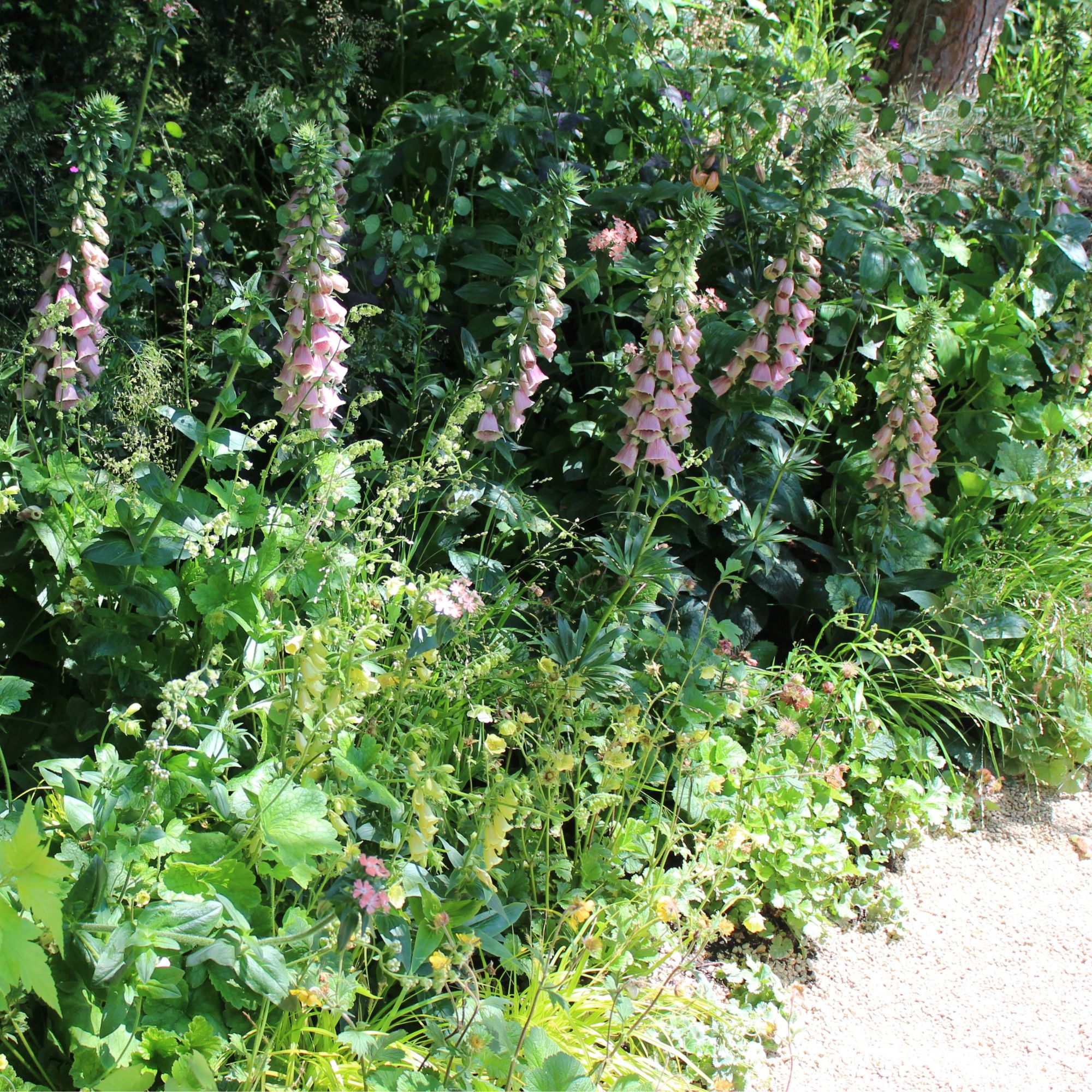10 of the best plants for bees – add these to your garden to lend pollinators a helping hand
With the right planting, you can create a haven for bees


Bees are among the most important wildlife you'll find outside – as one of the top pollinators, they help our gardens thrive, enabling the production of fruits, berries and nuts. Incorporating the best plants for bees into your garden can transform it into a haven for pollinators.
The best bee garden ideas include plants that pollinators love. The bonus? Most bee-friendly plants produce beautiful blooms that you can enjoy, too.
'Bees begin to wake quite early in the year and become more active as the summer progresses, so it's important to choose a variety of planting to give them the nectar they frantically search for through the warmer months,' says Andy Tudbury, head gardener at Belvoir Castle.
We've rounded up the best plants for bees to help inspire your best wildlife garden ideas yet.
1. Foxgloves

Foxgloves are one of the most popular bee-friendly plants – they love the bell-shaped flowers, and you'll often see them crawling inside to collect nectar.
'I often use Digitalis, or foxgloves, in my planting schemes,' says garden designer Harriet Worsley. 'The bees go mad for them, shuffling in and out of the fairytale bell flowers.
'The tall plants are like ladders for bees – the lower flowers are nectar-light but pollen-heavy. The higher flowers are nectar-heavy, so the bee works its way up to find the nectar, taking the pollen from the lower flowers with it.'
Sign up to our newsletter for style inspiration, real homes, project and garden advice and shopping know-how
Luckily, learning how to plant foxgloves is simple. Be careful if you have children or pets, though – foxgloves are poisonous, so keep them out of reach.
Where to buy foxgloves:
- Sarah Raven: a beautiful range of foxglove plants are available to choose from.
- Amazon: take your pick from a wide selection of foxglove seeds.

Garden designer Harriet Worsley set up Worsley Design & Consultancy after studying garden design and planting design and studying for her RHS Certificate of Horticulture. She has designed everything from small London roof terraces to large country gardens.
2. Buddleja

Buddleja, also known as the butterfly bush thanks to its popularity among pollinators, is much-loved by bees. Bees love purple tones, and many buddleja varieties produce purple flowers. However, they can also be found in other colours, like white or magenta, to match your planting scheme.
'Buddleja can grow quite tall if you allow it to, and it self-seeds freely,' says Andy from Belvoir Castle. 'Place a buddleja in a sunny position and it will reward you in high summer with clusters of small flowers that will draw in the bees and butterflies. Some people find the fragrance appealing, although it can be pungent to some.'
Where to buy buddleja:
- Gardening Express: try the deep-purple Buddleja davidii 'Black Knight' plant.
- J Parker's: a wide range of buddleja plants are available to choose from.
Andy Tudbury is head gardener at Lincolnshire’s Belvoir Castle. Andy’s extensive career began as a garden designer where he established Halcyon Days Garden Design and has created 28 impressive show gardens. Andy is in charge of looking after Belvoir’s stunning grounds including the Formal Gardens, Japanese Woodland and Duchess Garden.
3. Catmint

Catmint is another purple-flowering option, and it's also one of the best ground cover plants to prevent weeds.
'This plant has small tubular flowers for easy access, and it also has very long flowering periods, which makes it ideal for gathering nectar,' says Andy Ellis, former professional gardener and founder of Posh.co.uk. 'To encourage a second bloom, cut it back after the first flush of flowers.'
Where to buy catmint:
- Crocus: take your pick from this selection of catmint plants.
- Suttons: more catmint plant varieties to choose from.
4. Bellflowers

We're circling back to another bell-shaped favourite – Campanula, more commonly known as bellflowers, are well-loved by bees.
'Bees are very attracted to the bell-shaped blooms from this flower, and they provide plenty of nectar,' says Andy from Posh.co.uk. 'You should deadhead them to keep them blooming for longer, which will benefit the bees, and they prefer full sun.'
Where to buy bellflowers:
- J Parker's: a vibrant selection of Campanula plants to browse.
- Amazon: a range of Campanula plants and seeds to add to your garden.
5. Honeysuckle

Honeysuckle is another fragrant option to consider when choosing the best plants for bees. It's a great easy climbing plant which can be trained along trellises to double up as both decoration and a ready source of nectar.
'If you ever supped on honeysuckle flowers as a child, you will know that each flower contains a surprisingly sugar-rich bead of nectar,' says Annelise Brilli, horticultural expert (and bee lover) from Thompson & Morgan. 'The intense scent of honeysuckle advertises this feast far and wide. Although the tubular flowers are designed to attract long-tongued bees, short-tongued bees will often just bite a hole through the flower to reach its sugary reward.'
Where to buy honeysuckle:
- Gardening Express: a vibrant selection of honeysuckle plants are available to choose from.
- J Parker's: consider adding these fragrant honeysuckle plants to your garden.

Annelise Brilli is the horticultural copywriter for Thompson & Morgan. Annelise caught the gardening bug from her mother, whose tiny backyard was crammed with a huge collection of plants. She is passionate about sustainable gardening and has developed her own wildlife-friendly garden which she has opened as part of Macmillan Coastal Garden Trail.
6. Lavender

No list of the best plants for bees would be complete without lavender. It's one of several bee-friendly herbs that looks and smells great in the garden.
'The sound of bees buzzing and the sweet scent of lavender are two of my favourite things about an English summer, even better when experienced together,' says Harriet Worsley. 'Bumblebees love lavender, and are attracted by the heady summer scent – their long tongues are ideal for reaching into the flowers to find the nectar.
'My favourite is the English lavender Lavandula angustifolia, and the added value is that lavender is evergreen, so its leaves look good in the winter.'
Once you know how to grow lavender, both you and your visitors can enjoy beautifully scented pots and borders.
Where to buy lavender:
- B&Q: get your hands on a lavender shrub for a bee-friendly garden.
- Crocus: more lavender plants to choose from.
7. Bee balm

The clue is in the name of this one – bee balm actually belongs to the flowering Monarda genus in the mint family, and the vibrant blooms are well-loved by bees.
'The tubular flowers of this plant are rich in nectar, providing bees with all they need,' says Andy from Posh.co.uk. 'Of course, bees aren't the only pollinators they will attract, and they look beautiful in the garden. Keep them in full sunlight and divide them every few years to prevent overcrowding.'
Where to buy bee balm:
- Gardening Express: have a browse through these bee balm plants.
- Thompson & Morgan: we love this Bee Balm Kew Pollination Seed Collection.
8. Purpletop vervain

Another purple-flowered favourite, Verbena bonariensis is also one of the best drought-tolerant plants you can grow in the garden.
'This elegant plant has delicate stems with small purple or burgundy flowers that sit on top of the stems as the ideal landing pad for a bee or two,' says Andy from Belvoir Castle. 'I like to think that the circular plate-shaped clusters signal that 'dinner is served' to passing bees and butterflies!
'Planted in a sunny spot, the stems will grow strong and give a good mid-height to any flower border. They always remind me of my grandmother's net curtains because of the way they stop the eye but also allow you to see beyond.'
Where to buy Verbena bonariensis:
- Thompson & Morgan: buy ready-to-plant Verbena bonariensis for bee-friendly borders.
- Suttons: stock up on Verbena bonariensis 'Purple Elegance' seeds for next year.
9. Crocus

We couldn't forget to mention flowering bulbs on our list of the best plants for bees. Nectar-rich Crocus flowers make beautiful additions to pots and borders, and bees love them.
'If you want to help bees and other beneficial pollinators thrive, Crocus is a must-have,' says Annelise from Thompson & Morgan. 'Starving bees emerging from hibernation need energy-rich nectar to boost foraging, nesting and breeding activity plus protein-rich pollen to feed their larvae. Flowering in February and March, Crocus tommasinianus is one of their earliest food sources and naturalises readily.
'Follow it up with one of the larger flowered Dutch varieties such as the wonderfully stripey ‘Pickwick’ mixed together with the richly coloured ‘Dutch Purple’.'
Where to buy Crocus bulbs:
- Crocus: a huge selection of Crocus bulbs to choose from.
- Dobies: browse through a vibrant range of Crocus bulbs.
10. Winter clematis

Clematis is a stunning climbing plant all year round, depending on the variety, but winter-flowering varieties can provide bees with nectar when other plants have stopped blooming.
'This plant is very important during the colder months because it helps keep bees alive and provides them with nectar and nourishment when all of their usual plants have stopped flowering or died,' says Andy from Posh.co.uk. 'It might just be the most important pollinator plant. Prune it after flowering to help control growth.'
Where to buy winter clematis:
- Gardening Express: add the winter-flowering Clematis 'Winter Beauty' plant to your garden.
FAQs
What plants are best for bees to make honey?
The best plants for bees are rich in nectar, which bees bring back to the hive to make honey. All of the above suggestions will provide bees with plenty of nectar, but alliums, coneflowers and goldenrods are also brilliant options if you want to lend them a helping hand.
What do bees dislike?
While the list of plants that bees love is long, a very small number of plants have the opposite effect.
Citronella, while a common tactic for getting rid of mosquitoes, is also offensive to bees. They also dislike wormwood because it contains absinthe, which is toxic.
So, that's our list of the best plants for bees. It's by no means exhaustive, but these stand out as our favourite bee-friendly plants. Which ones will you be adding to your garden?

Sophie joined the Ideal Home team as Gardens Editor in June 2024. After studying English at Royal Holloway, University of London, she began writing for Grow Your Own, which spurred on her love of gardening. She's tried growing almost every vegetable under the sun, and has a soft spot for roses and dinnerplate dahlias.
As Gardens Editor, Sophie's always on the lookout for the latest garden trend. She loves sharing growing hacks for every space, from herbaceous borders to balconies.